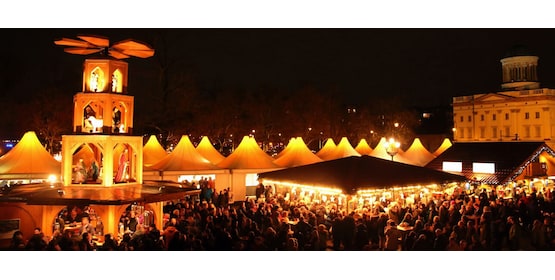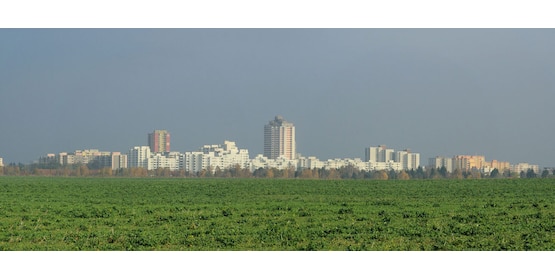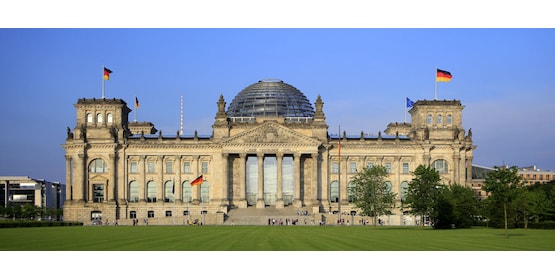Dresden
This city is one of the most famous places to visit near Berlin. It is known as the Florence on the Elbe, where baroque and rococo architectural splendor transports visitors to an era of majesty. After World War II, the city was left in ruins, but gradually managed to rebuild itself back to a reflection of its original splendor.
Dresden is known for having an artistic community in the Neustadt district that adds a creative touch to the streets with art installations, galleries, street graffiti and vibrant facades. As a recommendation, if you have chosen this city for a day trip, we advise you to mark on the map the Theaterplatz square, the Church of Our Lady, the Zwinger Palace, the Royal Palace and the Fürstenzug.
Dresden's Theaterplatz is located in the heart of the city and is home to historic monuments, Baroque palaces and impressive museums such as the Fürstenzug mural portraying 35 prominent German figures, the majestic Zwinger Palace, the Hofkirche and the imposing Semper Opera House. Each of these corners tells a fascinating story and is an ideal backdrop for strolling and capturing unforgettable images.
The Church of Our Lady (the Hofkirche) is a completely rebuilt Lutheran cathedral that stands as a symbol of resilience. The stone dome offers a panoramic view at a height of 67 meters, while the basement houses an exhibition hall that tells the story of the church's moving reconstruction after the war.
The Zwinger Palace has a baroque architecture of the 18th century and is built around a central garden. This building houses the Alte Meister gallery and the Meissen Porcelain Museum. First, it impresses with its dense ornamentation, highlighting the sculpture that has as protagonist Hercules and a terrace that can be accessed to enjoy panoramic views of the Royal Palace.
The Royal Palace, known in German as Residenzchloss, is the former residence of the Saxon Kings. It was painstakingly reconstructed and today, all visitors can delight in the Green Vault. Although taking photographs is prohibited, it is a visit not to be missed. It also has an audio guide that immerses you in the rich history of the rooms.
Last but not least, the Fürstenzug. It is an impressive mural of more than 100 meters, consisting of 24,000 pieces of Meissen porcelain. This outstanding monument is a must-see for art history lovers because it is a total beauty.
The 24,000 pieces of Meissen porcelain converge to give life to this spectacular mosaic depicting the members of the House of Wettin, a distinguished dynasty of monarchs, dukes, counts and Saxon figures who left their mark for over more than 800 years. To stand before this mural is to revel in a testament to the rich history and lineage of the region. What is most remarkable about the Fürstenzug is that it has held up exceptionally well in the face of adversity. Miraculously, it survived the bombing that hit the city, thus preserving its historical and artistic value.
Brandenburg an der Havel
This city is a must visit if you are in Berlin since it is located one hour by train from the capital. It can also be reached by car, although it would take an hour and a half. Brandenburg is presented as one of the 16 federal states of Germany and is one of the five Bundesländer (federations) that extend in the territory that was once part of the German Democratic Republic. If you decide to visit this settlement near Berlin, we recommend visiting the Cathedral of St. Paul and St. John and the Altstadt.
The Cathedral of St. Peter and Paul was built in 1165 and is one of Germany's most hidden treasures. It is located between the calm waters of the Havel River and the charming Beetz Lake, in the picturesque area known as Dominsel or Cathedral Island. It was founded by King Otto I in 948 as the first exposed brick building in the region and is an architectural landmark.
Among the narrow streets of the Old Town (Altstadt) stands majestically the former Brandenburg City Hall. Built at the end of the 15th century, this red brick building was the epicenter of the administrative life of the city until 1715. It stands out from the rest of the buildings of the city for its characteristic tower that seems to want to touch the sky. In addition, the building has a facade ornamented with family coats of arms that will transport you to another era.
Today, the main building has been transformed into a restaurant that fuses history and gastronomy so you can try some of the traditional local dishes.
The Harz Mountains
The Harz National Park is one of the places to visit near Berlin, as it is only a 2-hour drive away. It is the result of the merger of the former "Hochharz" and "Harz" parks. It is a place full of exuberant natural beauty, with approximately 25,000 hectares.
This multi-state park has a diversity of ecosystems, from lush forests and impressive cliffs to tranquil marshes. It also has high-altitude areas, such as Brocken Peak, at 1141 meters, with unique views of Germany.
Harz allows protected habitats to follow their natural course, supporting vital processes without human intervention. Research and recovery projects, such as the exclusive lynx repopulation, reinforce this commitment to preservation. The park also seeks to bring natural beauty to the public by offering a wide range of annual events.
In the vicinity of the Harz mountains, you can find one of the towns to visit near Berlin called Aschersleben. It is a fairytale village where history intertwines with nature in an idyllic setting. This town, with roots dating back to 753, unfolds its fascinating history over the centuries. Named after the Saxon dynasty of the House of Ascania, the town was the capital of the principality of Anhalt-Aschersleben from 1252 to 1315, before passing to the Bishopric of Halberstadt. Subsequently, after the Peace of Westphalia in 1648, it was integrated into the Principality of Halberstadt and, in 1815, became part of the Province of Saxony in Prussia.
This town has a rich culture, reflected in the great diversity of architectural styles of its buildings. In the historic center, the Grauer Hof is a demonstration of Romanesque architecture, while the church of St. Stephani represents Gothic elegance. Finally, the Renaissance is evident in the town hall and the Krukmannsches Haus.
A ring around the historic center features neoclassical and Jugendstil (Art Nouveau) buildings, such as the Heckner-Bauten, which coexist with structures from the era of the German Democratic Republic.
Although half-timbered buildings are scarce in old Aschersleben, some incorporate this element on the upper floors. This absence is attributed to the availability of quality stone, the lack of large nearby forests and fires prior to the 16th century. It is a perfect place to complete your visit to the Harz Mountains and enjoy tasting some of the typical dishes of the area.













































